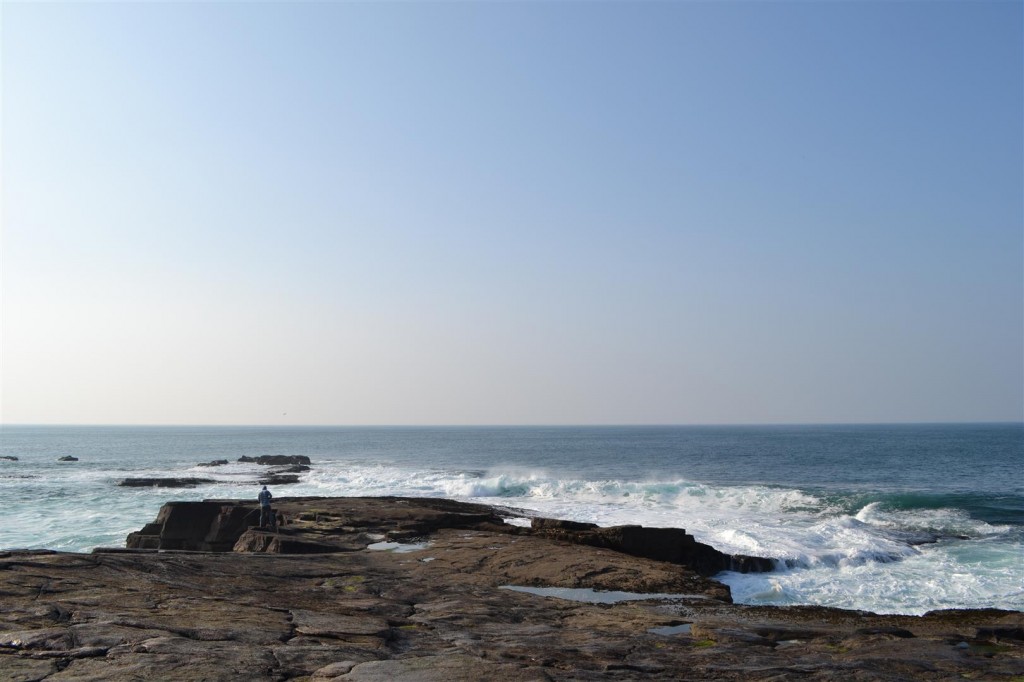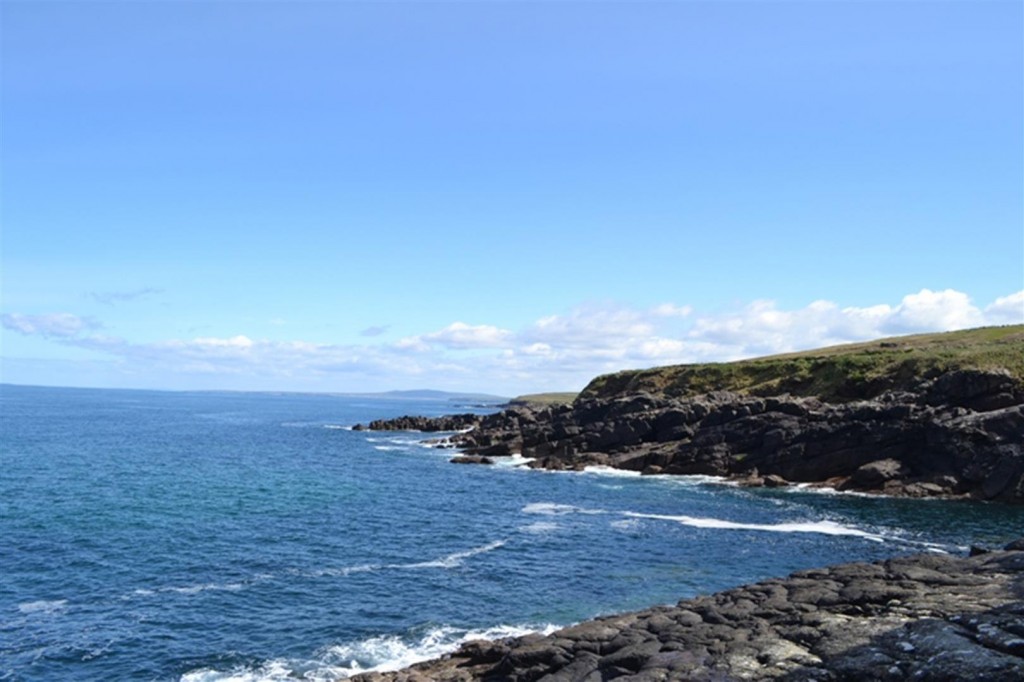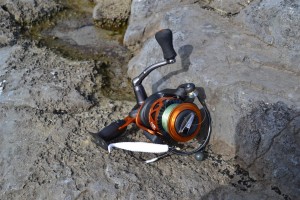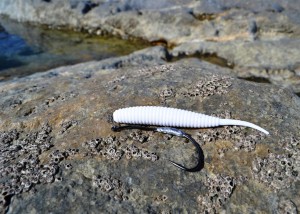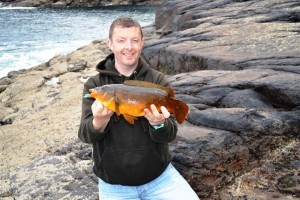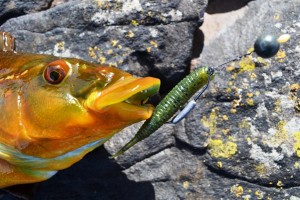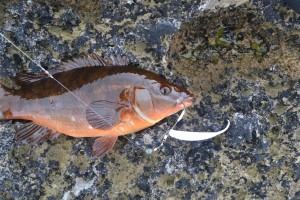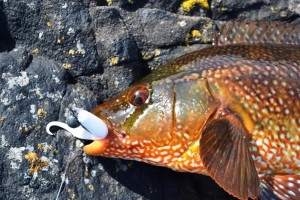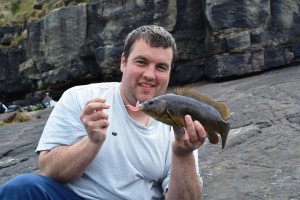Martin McGowan reckons he lives and fishes in a little bit of paradise. Kerry is certainly the location if you are searching out marks that have rarely if ever seen a fishing line. This time he tackles hard fighting Ballan Wrasse on soft lures.
As I opened my eyes at 8am last Sunday morning I was pleasantly surprised to see and feel the sun gloriously peeping through the window. A sun-filled day in Ireland – what are the odds! I cannot let this go to waste. Like they say “the two best times to fish is when it’s raining’ and when it isn’t!” Instantly I was on the blower to a good mate (John O Connor) to find out if he was available for a session, luckily he was. I informed him it was a spot of rock fishing I had in mind, and I did not have to do much convincing! A day of rock fishing it was. If you have ever perched yourself on the western shores of Ireland looking out at the wild Atlantic you will know exactly what I am on about. If you have never been you can only trust my words and feast on the pictures – it really is a piece of heaven.
I wolfed down an Irish breakfast (courtesy of my good wife), got my rod and gear together and headed to our arranged meeting point, there we packed up the car and continued on to our destination. John suggested to me we try a new mark he fancied for a while. He had spotted the area whilst fishing one day, and we all gladly agreed – new fishing marks always prove exciting and can lead to a rewarding day of fishing. In many areas a new mark can result in a blank but this is Kerry after all! We arrived after a 15 minute drive and wasted no time putting on our back-packs, grabbing our rods and making our slow descent to the rocks below.
As always safety is crucial when fishing from any rock marks, particularly new ones. A few words of advice for any novice angler who is fishing new ground: suitable footwear is vital; boots with a good grip and strong ankle support are recommended. It is advisable to research the weather forecast beforehand to make sure it is appropriate; for rock fishing dry and calm conditions with little or no swell is best – the last thing you want is a wasted journey! When you arrive at your destination take note of any dangers such as ease of access to the rocks, the swell, wind direction and freak waves. Also pay attention to sea weed; it is extremely slippery which may cause you to easily lose your footing. If you are not familiar with the moods and power of big swells I would suggest that you speak with locals to determine whether an area is safe.
It was our first time in this area so we carefully assessed the new ground; the climb down was not for the faint hearted and we were concerned. Nonetheless after a careful descent we made it down safe and sound.
As we took in our surroundings ‘amazing’ was one word that quickly sprung to mind! The waters were crystal clear, a lovely ledge ran across the front of us and there was a deep gully to our left which looked bottomless. Around 15 yards out from our rock was another cluster of rocks, which we hoped was home to some hungry Pollock – yes this was shaping up to be a good day. As we chatted amongst ourselves ‘Wrasse’ and ‘Pollock’ were the hot topics, and so we began the task of setting up. I was using a Berkley Phazer ll rod, an Okuma Tiro 40s spinning reel loaded with (Sufix 832) 8 strand 20lb braid I started off using a 5” crystal shad on a Texas rig. Amongst my selection of lures was an assortment of coloured (green, black, white and brown) ‘Yoshikawa Superwarm Softlures’. I was a bit of a ‘Doubting Thomas’ regarding the white lures – from past experience the darker coloured lures seemed to suit the Wrasse better, but who was I to dictate the menu for the day! John decided to fish using ‘Savagear Sandeel” lures.
The white lures fished using the Texas rig style were obviously the right choice for me and I was landing fish from the second cast. I landed a nice Wrasse of varying colours – this called for the camera. The largest of the Wrasse family the ‘Ballan’ can sport a bewildering range of colouration. Juveniles are often emerald green, but the colouration of Wrasse can vary from various shades of greens and browns to dark purple with white spots.
We were happy to say the least and never looked back from the first cast. We were landing fish after fish, and the great conditions were just adding to the experience. John decided to switch and use some of my Superwarm Softlures (I had enough to go round) and the fish were practically jumping at them. The Wrasses were hitting the soft plastics like a bullet exiting a gun. They were doing so with such force it would send shivers up your back and an instant rush to your head. It was simply un-be-live-able!
The Rigs
Fishing using soft plastics on a Texas rig offers the angler so many more options as to where s/he can fish. The Texas Rig is one of the simplest methods of rigging a soft plastic worm and has been widely used since the 1950s. It can incorporate just about all shapes, styles and sizes of soft plastic lures. When rigging I use a soft plastic bait/lure, a bullet weight, a hitchhiker and a weedless hook. I begin by threading my soft plastic lure onto my hitchhiker coil. Subsequently using my thumb I measure the bend along the bottom of the soft plastic and then insert the hook at this point. Here I make sure the hook point is just beneath surface of the lure; this stops it snagging on weed/rocks. When doing this be careful not expose the point of the hook, and also ensure that your lure is as straight as possible. Next slide your bullet weight up along the main line before connecting it to your hook. Personal tip: just below the weight add a rubber bead or float/bait stop. This prevents your lead from banging off your knot and wearing it down resulting in loss of fish.
In summary – What you need to complete this setup:
Rubber Bead – Float/bait stop
Line -12lb fluorocarbon connected to braid
Weights – Bullet or ball
Weedless Worm Hook (Weighted or non weighted) – Size depends on the species you are after
Plastic Worm – The choices of soft plastic worms are endless
Hitchhiker – Small, medium or large depending on size of fish you are after
On this particular day we were lucky to fish in caves, over rocks, along the sea bed and we even picked up a spider-crab along the way. At one stage we just stood and watched in silence as the Wrasse followed the lures up to the surface and smacked into them right in front of us.
As a keen Wrasse angler I would have always fished using a selection of bait including crab and lugworm. However there is no comparison to fishing with soft plastic lures on light gear – it is extremely rewarding. Who thought the day would come where we spin for Wrasse rather than drop bait down the side of a rock and hope for the best.
The Tactics
When you are all set up and ready to go, time to catch fish. Your cast does not need to be the mother of all casts. A gentle flick out, the weight will carry the soft plastic a significant distance every time (especially on balanced tackle). When it hits the water leave it sink slowly to the bottom. As the soft plastic drops down, watch your line very carefully, and look for any kind of slight “twitch” or tug. This will many times indicate that a fish has hit the soft plastic lure, because the fish maybe probing and knock the plastic on the drop. If the bait makes it to the bottom without being taken by a fish, let it sit for a few seconds and then slowly crawl it through the cover and over rocks an inch or two at a time, stop and pause for a few seconds, and repeat the process. You will get the feel for it very quickly. I like to picture the plastic knocking and bouncing along, it’s a nice way to stay in touch with the lure. You will feel the lead knocking off rocks and bouncing around. Give the rod a lift to the 11 O’clock position, this will cause the lure to lift up off the sea floor. Then drop your rod tip to about the 8 o’clock position and allow the lure to slowly fall again, all the while watching the line for a take. Most wrasse bites will come as the bait falls back toward the bottom. When you do get the take quickly set the hook and bring the fish in. Wrasse will fight hard. Be prepared to give little quarter or the fish will break you off on snags or bury themselves in kelp. Set your drag at a level where the fish must work hard to take line back.
Targeting wrasse with plastics is a “personal” type of fishing. It really comes down to your “feel” for the tackle and the action of your lure. With some practice you will find the style and ideal setup that suits you, increases your catch and gets the most from these sporting fish.
Our fishing trip was the perfect fishing trip and this was evident in the whopping 36 fish caught throughout the session. As the old saying goes “There is certainly something in fishing that tends to produce a serenity of the mind.” I couldn’t agree more!
Martin McGowan is the driving force behind the Angling Hub Tackle shop based in Tralee. It is a most popular shop with the sea angling fraternity.
Website:

